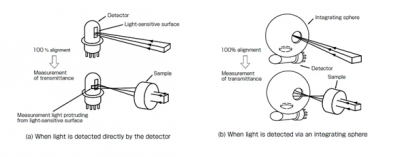A light-scattering substance, such as barium sulfate, is used to make the sphere’s spherical inner surface and inner wall. The light beam (measurement light) entering the sphere is equally scattered by integrating sphere.
The measuring light shines via an aperture in the center of the integrating sphere. The sample is put at this aperture to measure the light passing through the selection and entering the sphere. If possible, the detector should be placed in a gap not directly exposed to measurement light (often at the top or bottom of the integrating sphere).
LISUN LPCE-2 Integrating Sphere Spectroradiometer LED Testing System is for single LEDs and LED lighting products light measurement. LED’s quality should be tested by checking its photometric, colorimetric and electrical parameters. According to CIE 177, CIE84, CIE-13.3, IES LM-79-19, Optical-Engineering-49-3-033602, COMMISSION DELEGATED REGULATION (EU) 2019/2015, IESNA LM-63-2, IES-LM-80 and ANSI-C78.377, it recommends to using an array spectroradiometer with an integrating sphere to test SSL products. The LPCE-2 system is applied with LMS-9000C High Precision CCD Spectroradiometer or LMS-9500C Scientific Grade CCD Spectroradiometer, and A molding integrating sphere with holder base. This sphere is more round and the test result is more accruacy than the traditional integrating sphere.
High Precision LPCE-2(LMS-9000C) System Configuration (It is suitable for the Middle & Small Manufactory or General Test Lab):
High Precision CCD Spectroradiometer (LMS-9000C), Optical Fiber (CFO-1.5M), Digital Power Meter (LS2050B/LS2050C/LS2012), DC Power Source (DC Series), AC Power Source (LSP-500VARC or LSP-500VARC-Pst), Integrating Sphere (IS-1.5MA and IS-0.3M), Standard Light Source (SLS-50W and SLS-10W), 19 Inch Cabinet (CASE-19IN). You can download the detail PDF here: LPCE-2 (LMS-9000C) High Precision CCD Spectroradiometer Integrating Sphere System Brochure
It is possible to achieve uniform irradiance and brightness with the use of integrated spheres. Hollow, a spherical shell with highly reflective diffuse interior covering, is called an integrating sphere. There is no difference in the projected solid angle from any point on a sphere to any region on the sphere. This, along with the diffuse coating and many reflections, results in a uniform irradiance on and radiance of the sphere’s walls. This homogeneous lighting may be employed in an optical system thanks to a “port” in the sphere.
Integrating sphere in illumination
Integrating spheres is often used to evaluate scattering samples or samples that refract light, such as optical lenses. The light that passes through lenses that condense it after it has gone through a lens is used to do baseline correction when measuring transmittance in a manner that may be measured by a conventional detector (100 percent alignment).
This might cause inaccurate measurements since the sample has been irradiated, the light-sensitive detector surface protrudes from the model. It is impossible for light dispersed by a scattering sample to reach the detector’s light-sensitive surface if the sample has these qualities. An example may be accurately measured using an integrating sphere because all the measurement lights are irradiated on the light-sensitive surface of the detector at both baseline correction and sample measurement after being diffused within the integrating sphere at both.

Integrating sphere in illumination
Transmittance measurement
With no sample available, baseline correction may be applied. Standard samples (e.g., whiteboard loaded with barium sulfate) are inserted in apertures on reflection sides of integrating spheres. Scattered components and linear components are both assessed in a typical transmittance measurement.
Reflectance measurement
Measurement is carried out after a baseline correction using the standard sample (e.g., whiteboard filled with Barium Sulfate), which is placed at a point where the irradiated light from a measurement aperture and its reflections pass through an integrated sphere (reflection location).
Since reflectance is measured as a function of the standard sample, it is known as “relative” reflectance measurement. It is vital to record the standard sample’s reflected light to get an accurate reading. Also, keep in mind that reflectance varies when the reference sample is changed. LISUN has the top-of-the-line integrating sphere in the market.
Using a conventional detector approach, samples that cannot be accurately measured may be accurately analyzed using an integrating sphere. Integrating spheres are a good choice for measuring light-changing samples, such as semi-transparent or opaque solutions and lenses.

Lisun Instruments Limited was found by LISUN GROUP in 2003. LISUN quality system has been strictly certified by ISO9001:2015. As a CIE Membership, LISUN products are designed based on CIE, IEC and other international or national standards. All products passed CE certificate and authenticated by the third party lab.
Our main products are Goniophotometer, Integrating Sphere, Spectroradiometer, Surge Generator, ESD Simulator Guns, EMI Receiver, EMC Test Equipment, Electrical Safety Tester, Environmental Chamber, Temperature Chamber, Climate Chamber, Thermal Chamber, Salt Spray Test, Dust Test Chamber, Waterproof Test, RoHS Test (EDXRF), Glow Wire Test and Needle Flame Test.
Please feel free to contact us if you need any support.
Tech Dep: Service@Lisungroup.com, Cell/WhatsApp:+8615317907381
Sales Dep: Sales@Lisungroup.com, Cell/WhatsApp:+8618117273997
Your email address will not be published. Required fields are marked *